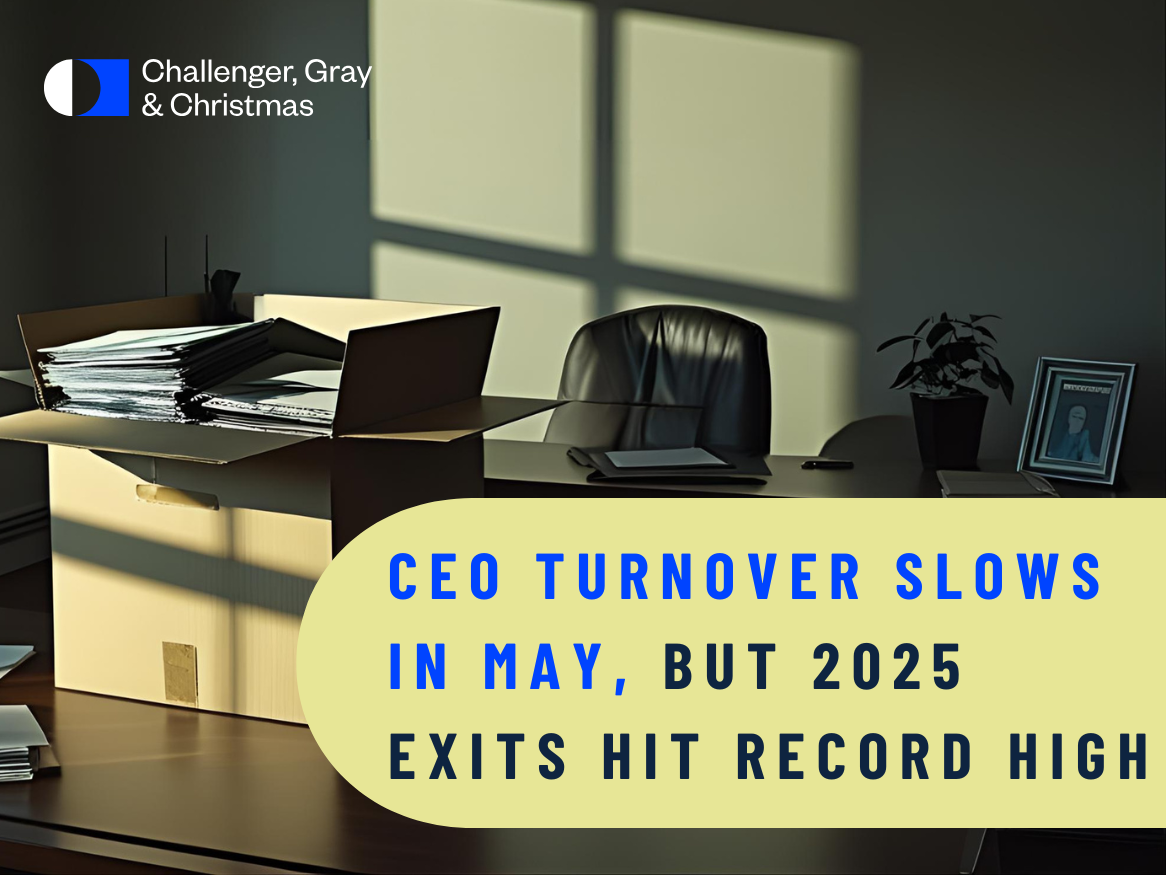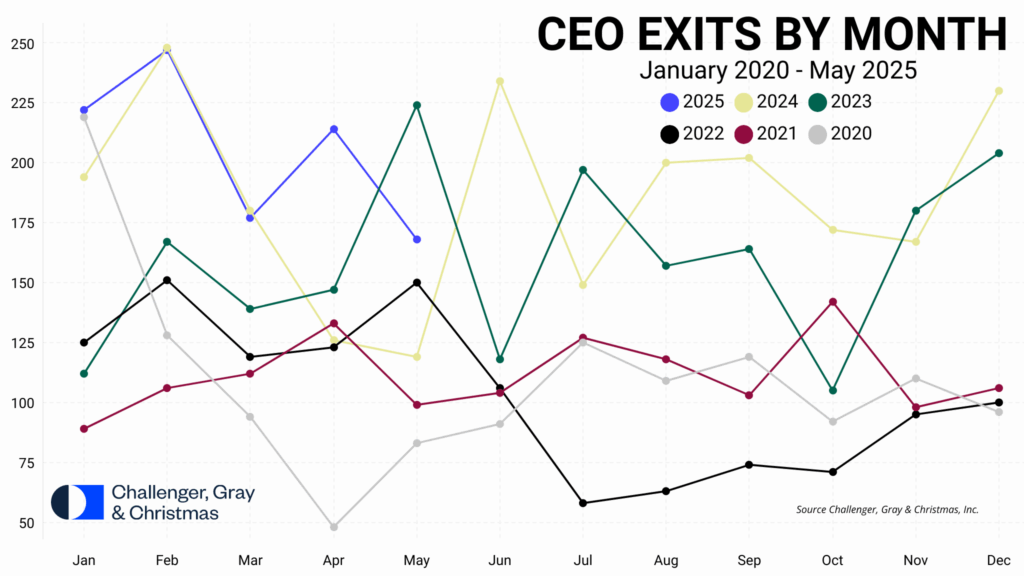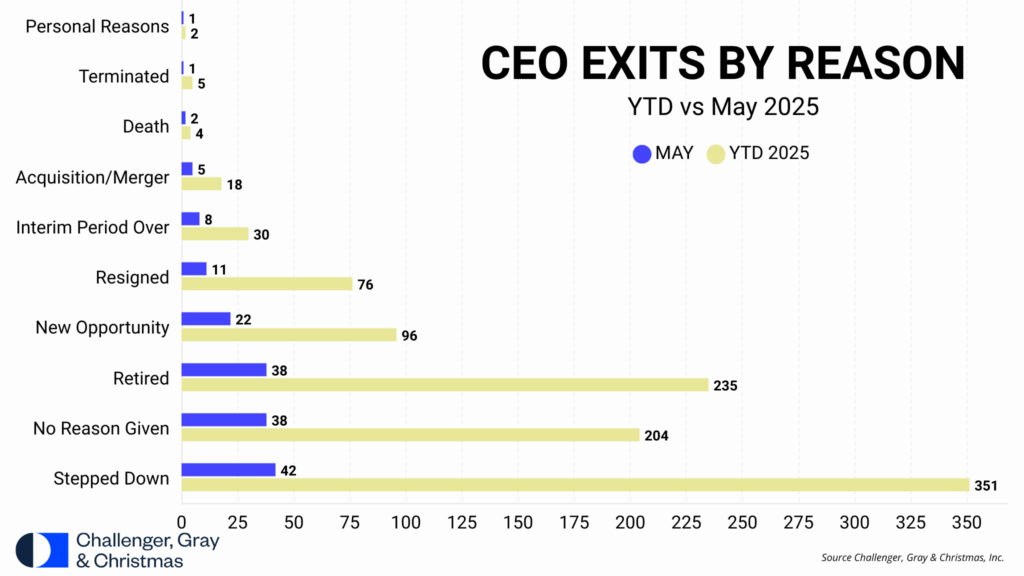
Jun 30 CEO Turnover Slows in May 2025; YTD Highest on Record
CEO Turnover Slows in May 2025; YTD Highest on Record
Alarm Bells Ringing on Downturn of Rising Women CEOs Rate of Interim CEOs Remains High
Published June 26, 2025
The number of CEO changes at U.S. companies fell 21% from 214 in April to 168 in May. This is a 41% increase from the 119 CEO exits that occurred in the same month one year prior, according to a report released Thursday by global outplacement and business and executive coaching firm Challenger, Gray & Christmas.
Long-tenured CEOs are leaving their posts this year, according to tenure data compiled by Challenger, Gray & Christmas. Through May, the average tenure for a departing CEO is just over 12 years, the highest tenure since 2017, when tenures averaged 12.7 years.
“The epic changes and uncertainty facing many companies right now may be the exit point for long- tenured CEOs as companies deploy new strategies requiring new leadership,” said Andrew Challenger, Senior Vice President and labor expert for Challenger.
Through May, 1,028 CEOs left their posts, up 19% from the 867 CEOs who left their posts during the same period last year. This represents the highest YTD total on record. Challenger began tracking CEO exits in 2002.
INTERNAL v. EXTERNAL CEO REPLACEMENTS
Challenger has tracked whether new CEOs are internal or external for 929 replacement CEOs so far in 2025. Companies are virtually split on bringing in an external hire (49.99%) versus growing someone internally (50.01%).
WOMEN CEOs
The rate of new CEOs who are women held in May from April at 25% and well below the 29% of new CEOs who are women appointed in January to May 2024.
Meanwhile, 56% of the women who are leaving their roles are being replaced by men, compared to 48% during the same time period last year.
Meanwhile, women are replacing outgoing male CEOs 20% of the time in 2025, compared to 23% last year.
“This is an alarming trend. The gains women have made over the last decade, which remain far from equitable, are beginning to slip in the current political environment which includes rhetoric that repudiates diversity, mentorship, and equity. While we believe companies are still invested in these things – as companies that do have an easier time retaining and attracting talent and have higher engagement and productivity – the decline of rising women CEOs is troubling,” said Challenger.
WHAT INDUSTRIES ARE SEEING TURNOVER?
The Government/Non-Profit sector continues to lead in CEO exits, reporting 34 transitions in May 2025, down 20.9% from April’s 43 and 54.8% lower than May 2024’s 22. Of those, 5 occurred at Hospitals, down from 15 in April and 10 in May 2024. Year-to-date, the sector has recorded 212 CEO changes, the highest of any industry.
The Technology sector reported 20 CEO exits in May, up 25% from April’s 16 and more than double the 9 exits reported in May 2024. Year-to-date, Technology leads private-sector industries with 114 CEO changes, up from 93 at this time last year.
The Health Care/Products industry saw 15 CEO exits, down 42.3% from April’s 26 and flat compared to May 2024. The Hospital subset within this industry reported 5 exits, a 66.7% decline from April and down 50% from May 2024.
In Entertainment/Leisure, there were 19 CEO changes, up 18.8% from April’s 16 and a 171.4% increase over the 7 exits reported in May 2024.
The Financial sector saw 10 CEO changes, slightly down from April’s 11 and matching May 2024’s total. FinTech reported 1 exit, after recording none in April and May of last year.
Construction reported 1 CEO exit, a sharp drop from April’s 5 and flat compared to May 2024. Still, the sector has seen a total of 22 exits year-to-date, up from 14 at this point in 2024.
The Energy sector recorded 5 CEO changes in May, up from 3 in April and 25% higher than May 2024. Year-to-date, the sector has seen 26 exits, compared to 17 last year.
In Retail, 4 CEOs exited in May, down from 5 in April but up from zero in May 2024.
REASONS FOR EXITS
Challenger tracks CEO departures based on the language used in company announcements. The leading reason for CEO transitions year-to-date remains “Stepped Down,” cited 42 times in May, bringing the 2025 total to 351. This reason typically indicates the CEO remains with the organization in some capacity—often on the Board or during a transitional period.
“Retired” was the second most common reason for departure, cited 38 times in May, for a year-to-date total of 235, up nearly 30% from the 181 retirements reported during the same period in 2024. This rise in retirements, combined with the highest average CEO tenure since 2017, suggests further that many long-tenured leaders are exiting as companies face increased strategic, economic, and political uncertainty.
“No Reason Given” was cited in 38 cases in May, bringing the total for 2025 to 204, indicating continued opacity in leadership change communications.
“New Opportunity” accounted for 22 CEO departures in May, up from 20 in April and bringing the year-to-date total to 96. This marks a notable increase from the 38 citing this reason by this time in 2024, suggesting increased CEO mobility or a stronger leadership job market.
“Resigned” was listed as the reason in 11 May transitions, for a total of 76 in 2025.
“Interim Period Over” was cited 8 times in May, bringing the total to 30 for the year—well below the 57 interim completions reported by this point last year. This trend may indicate that fewer interim CEOs are being replaced by permanent successors so far in 2025, giving further evidence that companies are relying on interim leaders.
Less frequently cited reasons in May included:
- “Acquisition/Merger” – 5 exits (YTD: 18)
- “Terminated” – 1 exit (YTD: 5)
- “Personal Reasons” – 1 exit (YTD: 2)
- “Death” – 2 exits (YTD: 4)
Additional reasons with one report each year-to-date include: Differences with Board, Allegations of Professional Misconduct, Loss of Contract, Relocation, and Bankruptcy/Restructuring.


